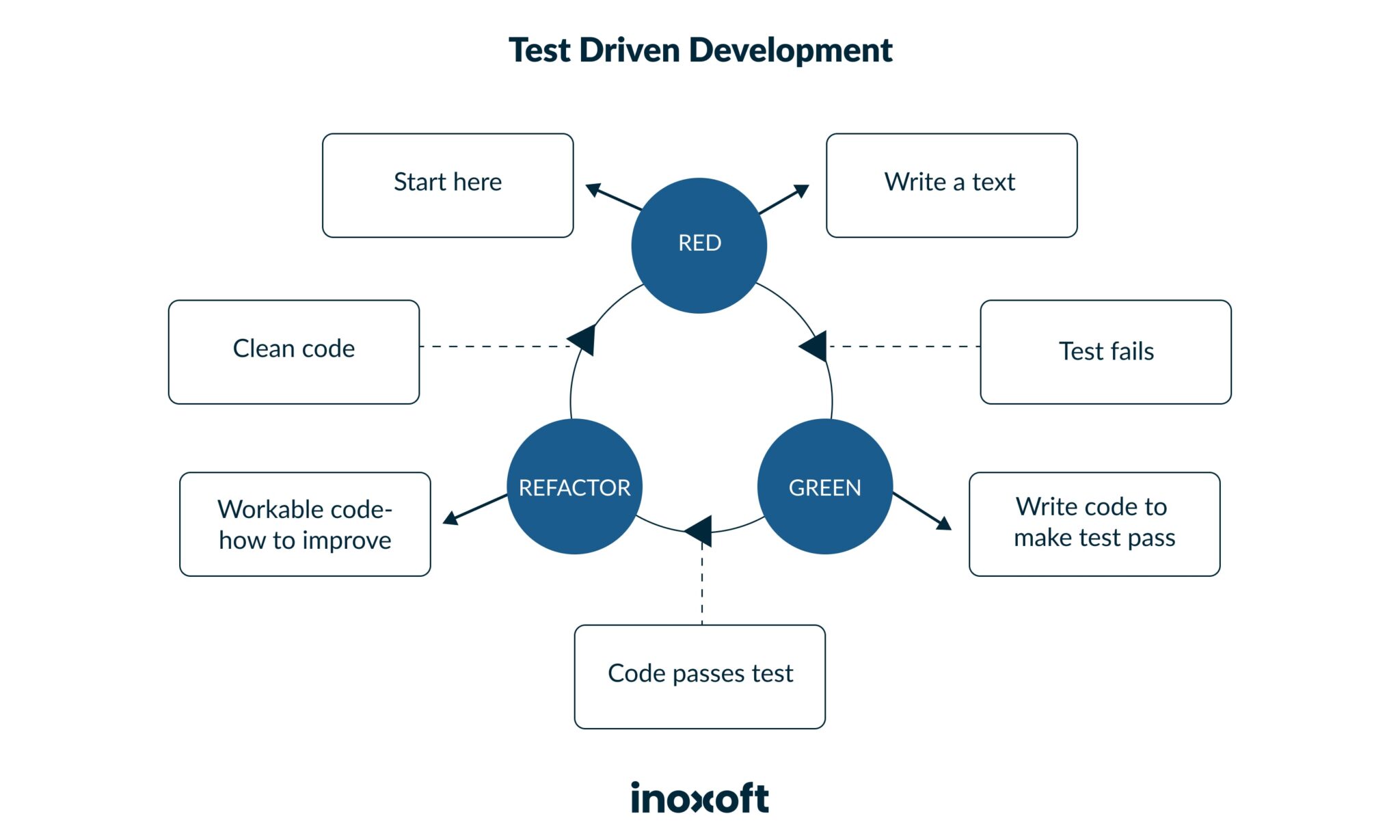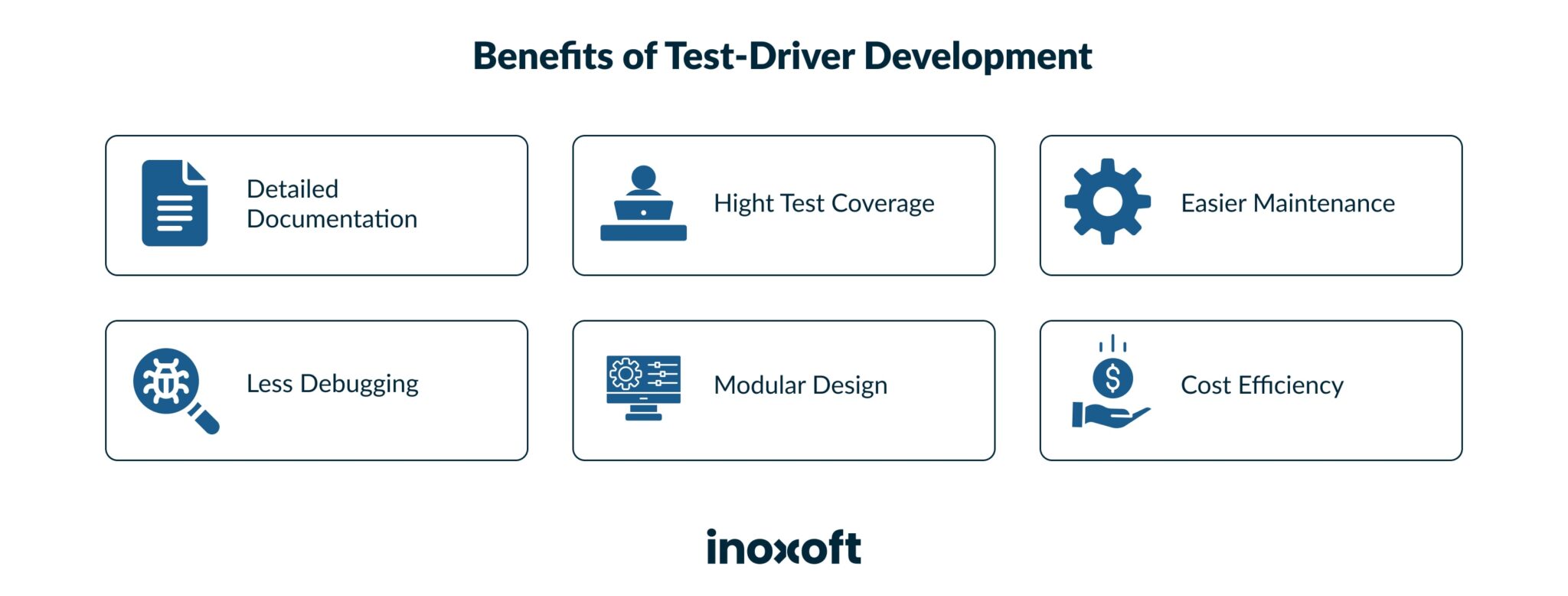Nowadays, constantly updating the software to keep up with the competitors is vital. The point is to deliver a high-quality product without the slightest defects that could bother the end-users. Responding to rapid changes and innovations, developers have no choice but to adapt to this expressway workflow. That’s why the agile development model has gained so much popularity within the industry.
According to the Agile manifesto for software development, continuous attention to technical excellence and good design enhances agility. But how can we do it? What technical practices should we apply? Is the practice of Test Driven Development good enough? In this article, you’ll get answers to those questions and more! We will discuss the concept of TDD, what it has to do with Extreme Programming (XP), and elaborate on the pros and cons of test driven Development.
- Defining Test Driven Development Approach
- Red cycle
- Green cycle
- Refactor
- How TDD is Used in Agile
- Benefits of Test-Driven Development
- High test coverage
- Modular design
- Less debugging
- Detailed documentation
- Easier maintenance
- Cost efficiency
- Disadvantages of TDD
- Final Thoughts
- Consider Inoxoft’s Team as TDD Development Experts
Defining Test Driven Development Approach
Test driven development is a software development method that creates unit test cases before writing and developing the actual code. It helps develop clear and user-friendly software APIs with simple yet focused and well-tested codes that are easy to maintain. We may describe it as a mix of programming, creating unit tests, and refactoring.
The concept of TDD goes back to the 20th century. Regardless, precisely 20 years ago, Kent Beck – an American software engineer and the creator of the extreme programming methodology – rediscovered it.
The original description of TDD was in an ancient book about programming. It said you take the input tape, manually type in the output tape you expect, then program until the actual output tape matches the expected output. After I’d written the first xUnit framework in Smalltalk I remembered reading this and tried it out. That was the origin of TDD for me. – Kent Beck
Source: Test Driven Development: By Example
Red cycle
In the Red cycle, the developer starts by writing a failing test case, which is designed to capture the intended functionality or behavior of the code based on their intuition. The actual code may not exist or may be incomplete, and running the tests should result in failures since the functionality hasn’t been implemented yet.
Green cycle
Once the failing test is in place, the developer proceeds to write the minimum amount of code necessary to make the test pass — the goal is to implement the functionality required to satisfy the test case. “Green cycle” because we expect the test to pass after the implementation. Still, the emphasis is on writing the simplest code to make the test pass, without unnecessary features or complexity.
Refactor
After the test has passed, the developer focuses on improving the code without changing its external behavior. Refactoring involves restructuring the code to make it more readable, maintainable, and efficient. The key is to enhance the code while keeping the tests green — it’s crucial for long-term maintainability and helps prevent the accumulation of technical debt. Finally, you may also repeat the full circle, which allows us to accumulate unit tests.
Discover the benefits of risk based testing in Agile!
What are the significant differences between traditional approaches to programming and development TDD? The first is much more linear: we focus on writing the code, focus on development, and then go to the testing phases. In the TDD process, we are all about conducting the tests in short phases, not even considering the overall result. This approach must ensure that code is safe and sound before moving further.
How TDD is Used in Agile
Test Driven Development is a technical practice of extreme programming, which is basically one of the agile processes. It’s not rocket science that the agile approach requires instant feedback of product development to develop the desired one. The process of Test Driven Development is iterative, so all of the mistakes and errors are easy to fix, thanks to the fast feedback. That’s one of the benefits of TDD in agile – we get all the data needed as soon as possible.
Strategies of regression testing in agile you need to know!
Hence, this framework perfectly fits into the agile environment since it prevents the team from delivering software with objectionable features. TDD helps strengthen communication between the team members from the QA and development departments and, of course, the client. Furthermore, Test Driven Development produces optimized code that will be resilient in the long run. Frequent feedback makes a high probability of engineering a high-quality product. Plus, the teams can save quite a bit of time since there’s no need to recreate test scripts — the tests are already in their pockets.
Benefits of Test-Driven Development
What are the benefits of TDD? Besides giving quick code-related feedback, there are plenty of other advantages of test driven development for your business. Here are the major ones:
High test coverage
The list of the benefits of implementing test driven development approach can’t go without assurance in the code. Since you develop tests for every feature, the test coverage must be much higher than in other development approaches. At the end of the day, we get a much better product quality thanks to the high test coverage percentage.
Modular design
In Test Driven Development, the developers pay precise attention to one feature at a time. They won’t even consider moving from their spots till all of the tests pass. Thus, the code is easier to check for defects, keep clean, and can even become reusable. If the code is modular, that means it’s unit-testable. And that leads to a better design for the application.
How to beta test a website in only 5 steps?
Less debugging
One of the benefits of applying TDD is the decrease in possible errors. Implementing changes in the enormous code massif might bring developers more headaches. And we know that the fewer bugs a code has, the less time it takes to fix it. Anyhow, IEEE Software publication states that implementation of TDD reduces the percentage of bugs by 40-80%! Test Driven Development is an actual lifeline since it helps to find and get rid of the defects at a very early stage.
Detailed documentation
This approach provides the documentation of each code – a massive privilege for the developers, especially time-efficient. While writing tests, they create a list of requirements. And it shows how code must be used and includes the scenario of the end-users possible behavior. Thanks to the unit tests, we have a code that meets all the requirements the most. Additionally, we don’t need to write documentation since tests will do it for us!
Easier maintenance
And the range of benefits of test driven development goes on! The next point relates to the modification of the code. As a rule of thumb, developers create clean, readable code that is easy to manage while applying the TDD. Thus, in case of an emergency, different members of the team can take over the task and be able to understand the purpose of the code.
Cost efficiency
Of course, the treasure of the TDD advantages – is the saving cost of the project development. And this is, actually, a logical outcome of the previous points. For instance, high test coverage leads to the high quality of the product. Also, there’s no need to spend resources maintaining the documentation or checking for plenty of bugs. By implementing Test Driven Development, the developers receive flexible codes that are easy to maintain and extend.
Disadvantages of TDD
The benefits of using TDD sound absolutely fantastic. Unfortunately, there’re also some aspects you should consider from the very outset of the project. Next is a list of cons you might face using Test Driven Development.
Learn the importance of testing MVP!
- Slow development process. The speed is definitely a weak spot of the TDD. To develop the product of the finest quality, Test Driven Development makes the process way slower than we would like it to be.
- Full team involvement. Unit testing is the phenomenon every single team soul must master. Or at least understand the basics of its principles. Believe it or not, writing proper unit tests before writing the code is not as easy as it sounds. Prepare to allocate plenty of development time to study this methodology thoroughly.
- Constant maintenance. All the changes need to be consistent with tests and codes. And that’s definitely not part of the benefits of TDD – each team member has to maintain tests correctly. Otherwise, the system will impair at lightning speed.
- Steep learning curve. It might be hard to start working in a brand-new direction that is entirely foreign to you. Therefore, the TDD approach needs a fully dedicated team that is not afraid to learn and be mistaken.
Final Thoughts
Test Driven Development is a reliable coding practice that provides your business with accurate and robust solutions. As an agile approach to the development path, implementing this framework will definitely lead to a successful outcome. Yet, we’ve looked through both TDD pros and cons. So now it’s up to you to decide whether the Test Driven Development is genuinely worth it or not. Keep in mind that the exploration of it requires time, a bunch of attempts, and failure. But that doesn’t really matter when you have a deep desire to master this new programming technique. Just don’t give up – everything will work out in the end!
Consider Inoxoft’s Team as TDD Development Experts
The environment you work within plays a crucial role in creating successful projects. And it seems like Inoxoft is a perfect match for it! As an international software development company, we provide the finest software test automation services on the market. Our company aims at powerful applications to lay the foundation for long-term business success. Inoxoft QA engineers have profound coding skills and experience working with automation tools and frameworks. Also, they are able to design automated tests and documentation to streamline processes.
Moreover, we suggest our partnership and expertise in Test Driven Development. Learn more about our services, read our clients’ reviews, and convenience yourself to become one! If you are interested in our company, do not hesitate to fill out the contact form below.
Frequently Asked Questions
Why is it important for TDD developers to fail the test?
Let’s think logically: when you write a test for the code you haven’t implemented yet, the test must fail due to the lack of features. If your tests pass, it’s not really unique, valuable, or meaningful for you. The test failure gives you the food for thought on how to write a code that would allow the test to pass.
What are the benefits of TDD?
Besides giving quick code-related feedback, there are plenty of other advantages of test-driven development for your business.
- High test coverage
- Modular design
- Less debugging
- Detailed documentation
- Easier maintenance
- Cost efficiency
What is one of the major business related benefits of TDD?
All the benefits of using TDD lead to the cost efficiency. High test coverage leads to the high quality of the product. Also, there’s no need to spend resources maintaining the documentation or checking for plenty of bugs. By implementing Test Driven Development, the developers receive flexible codes that are easy to maintain and extend.










